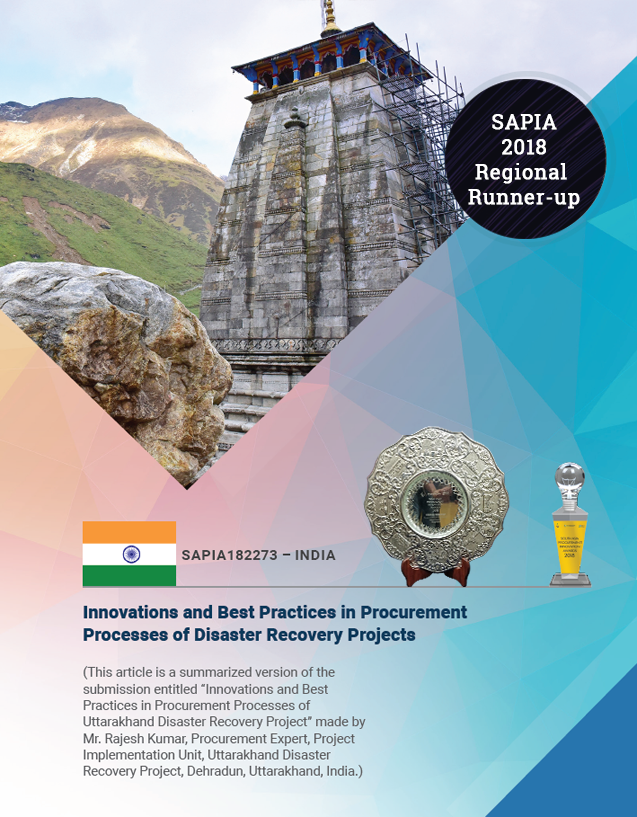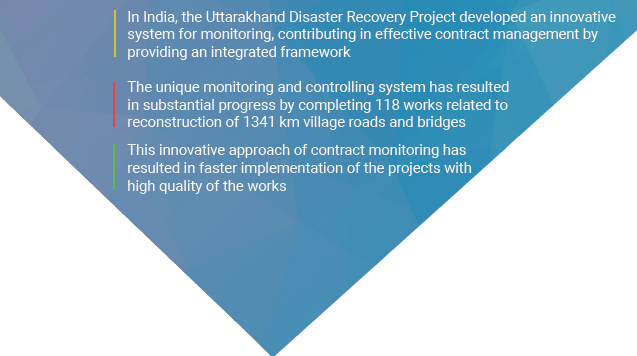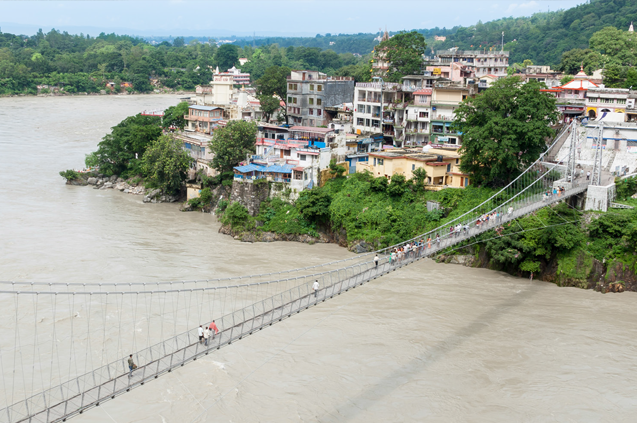Feature Stories
- How Bangladesh bridged the gap between amateur and professional in government procurement
- Rated Criteria: Promoting Value in World Bank Procurement
- Public Procurement Transformation in Bangladesh
- Achievement of Value for Money and Enhancement of Efficiency, Economy and Transparency in Procurement - Document Archive System
Archives
- End-to-End Procurement Planning and Maintenance System Integrated with Project MIS
- Application of Construction Milestones in Rural Road Contracts of Nepal
- Gross National Happiness Model for Pursuing Sustainable Public Procurement
- Government procurement is the basis of wide opportunities for enterprise development
- The Challenges of Procurement Training in a Fragile Country: the Afghanistan Experience
- When and How to Open Contracts: Transparency and Engagement through World Bank Projects
- Innovations and Best Practices in Procurement Processes of Disaster Recovery Projects
- World Bank Experts Discuss Global Procurement Trends and Armenia's e-GP system with the National Assembly
- Technology driving transparent and accountable public procurement reform in Bangladesh
- Prototype for Implementation of Framework Agreement via Blockchain
- Construction Project Planning and Management Capacity Building in India: A Wholistic Approach to Boost Infrastructure Development
- Zimbabwe: Public Procurement reform to catalyze greater transparency and development
- 15th Procurement, Integrity, Management and Openness (PRIMO) Forum
- e-Procurement World Map
- Preventing and controlling corruption: A modern approach to Procurement
- 6th South Asia Public Procurement Conference held in Thimphu, Bhutan
- South Asia Procurement Innovation Awards 2018 Announced
- Procurement iNET completes 5 years and new CPPP Fastest 100% Challenge Launched
- Risky Business: Does Debarring Poor Performers Mitigate Future Performance Risk?
- Global Procurement Summit 2019, New Delhi, India
- World Bank India launches Survey for International Civil Works Contractors
- World Bank launches new Complaints Module in Systematic Tracking of Exchanges in Procurement (STEP) System
- New Open Contracting Data Standard for e-Procurement Systems Launched
- Bangladesh's success in public procurement: Sustained reform really pays off
- The five drivers for improving public sector performance: Lessons from the new World Bank Global Report
- South Asia Public Procurement Innovation Awards 2018
- Conversation with Khaled Elarbi, President, High Authority for Public Procurement (HAICOP), Tunisia on the Digitalization of Public Procurement
- Breaking the glass ceiling in Africa: Rwanda E-Government Procurement System
- How government e-marketplace is revolutionizing procurement in India
- Ensuring Value for Money in Infrastructure Projects - The Botswana way
- Blockchain Lessons for Procurement
- Botswana’s Benevolent Move to Enhance its Procurement Profession
- Achieving Better Value for Money Using e-Auction for Procurement of Goods by Public Sector - A Success Case from DPDC
- Guide to Project Management and Contract Management (GPMCM) – New Approach to Improve Efficiency and Effectiveness of Procurement Outcomes
- Regional Winners of SAPIA 2017 participate in 8th International Public Procurement Conference (IPPC 8) Arusha, Tanzania
- The Future of Public Procurement in the Era of Digitalization
- World Bank Operations Procurement Helping Turkey to Procure a US$2 Billion Gas Storage Facility
- Unlocking Energy Efficiency Market in India - Through Innovative Procurement Business Model
- Getting value for money: Creating an automated market place for farmers in Pakistan
- Towards a Single Market for Public Procurement in Caribbean Small States
- Web-Based Online Evaluation Tool (e-Tool) for Procurement of Works by Royal Government of Bhutan
- Strengthening Health Sector Procurement System Offer Hopes for Universal Health Coverage in Nepal
- Morocco makes Strides in Modernizing its Public Procurement System— Operationalization of the Procurement Regulatory Body
- Innovations in Procurement Process and Selection that Lead to Improved Outcomes – Tenderers’ Database Management System
- Looking Back and Forward: The World Bank’s Procurement Framework
- Independent Monitoring and Evaluation of Contracted Health Services Leads to Improved Outcomes in Rural Areas of Afghanistan
- Fifth South Asia Region Public Procurement Conference brings focus on Procurement in Public Service Delivery
- 12 Procurement Innovations from South Asian Countries Celebrated
- Social Media is Improving Procurement in Lao PDR
- ASEAN meeting explores ways of professionalizing public procurement to meet development challenges
- Second International Training Program on the World Bank’s New Procurement Framework
- South Asia Procurement Innovations Award 2017 launched with Bigger and Better Prizes
- How to bid, finding opportunities, what makes a successful bid
- Pushing boundaries in procurement framework implementation
- Experience of Developing PPSD for the Assam Agribusiness and Rural Transformation Project (APART), India
- An Electronic Approach: Streamlining Georgia's Procurement
- South Asia Heads of Procurement Knowledge Exchange Program to U.S. Government Procurement Systems started
- 13th Procurement, Integrity, Management and Openness (PRIMO) Forum - a Documentary
- Bangladesh to strengthen public procurement with World Bank supported Project
- Establishment of Technology-Based Health Procurement and Supply Chain Management System, and Capacity Development in Tamil Nadu Medical Services Corporation
- Towards a Single Market for Public Procurement in Caribbean Small States
- Redefining Procurement as an Innovative and Collaborative Centre of Excellence for Best-in-Class Sourcing Solution
- India’s PowerGrid Endorsed for Alternative Procurement Arrangements by the World Bank
- Achieving Value for Money in Indonesia’s Geothermal Project
- Citizen Monitoring of Rural Roads Under Pradhan Mantri Gram Sadak Yojana (PMGSY), India
- Establishment of Grant and Service Contract Management Unit (GCMU) to Manage Contracting Out of Health Services in Afghanistan
- Procurement for Regional Development–Public Policy Initiative in Sri Lanka
- PPAF Community-Driven Development (CDD) Procurement Model, Pakistan
- Making Successful Procurement of IT Systems - An Experience from Vietnam
- Procurement Observatories continue to deliver in India
- Implementation of National e-GP System in Nepal
- Government e-Marketplace (GeM), India
- Africa High Level Public Procurement and Electronic Government Procurement Forums
- Development of Procurement Cadre as Part of Holistic Procurement Reforms in Bhutan
- Modernizing Public Procurement in Zimbabwe, one Step at a Time
- Citizen Engagement During Public Procurement Implementation in Bangladesh
- Winter 2017 Virtual Procurement, Integrity, Management, and Openness (PRIMO) Forum on Sanctions and Debarment Systems
- Close and Personalized Procurement Monitoring, Leading to Procurement Efficiency in Irrigation Sector in Fragile and Challenging Environments of Afghanistan
- Procurement Framework 2016 offers wider choices to ‘Go to Market’ based on PPSD
- Procurement Framework 2016 - Benefits, Status of Roll-out and M&E Arrangements
- PPSD offers Fit for Purpose Procurement Solutions
- Global Procurement Summit
- Fourth South Asia Region Public Procurement Conference
- The World Bank e-Procurement Tools
- South Asia Procurement Innovations Awards, 2016
- Learning Videos launched on STEP, online tracking tool on procurement for World Bank Projects
- Open e-Learning is Building a Cadre of Procurement Experts
- South Asia Region Public Procurement Conference, 2017
- Online Certificate Program in Public Procurement in Arabic Launched in Egypt
- First Procurement Knowledge Exchange Forum among ASEAN Countries
- Nobel Prize in Economics for contribution to Theory of Contract
- The Africa Region Harnesses Integrated e-Government Procurement (e-GP) Systems in Pursuit of Transparency and Integrity
- Procurement Reform for Humanitarian and Development Challenges in Kurdistan Region of Iraq (KRI)
- Successful Procurement is not just a set of Activities, it is a Strategy
- Afghanistan - Trends and Recent Developments in Governance
- PPSD is an Opportunity for clients and staff for Improved Procurement Management
- Procurement Reform Advances in the MENA Region
- Data Analysis and Collaborative Work in Action for Expedited Disbursements in Africa
- Ensuring Good Governance in Procurement in Sri Lanka
- New Procurement System to Improve Development Impact and Transparency in South Asia
- World Bank, USTDA Formalize Procurement Partnership
- How the New Procurement Framework Will Benefit 45.6 Million People in India
- Procuring the Future
- Reasons to Bid, Finding Business Opportunities
- New World Bank Procurement Framework Promotes Strengthened National Procurement Systems
- The readiness for Procurement Framework 2016
- 6 Things to know about New Procurement Framework
Innovations and Best Practices in Procurement Processes of Disaster Recovery Projects

Challenge(s) Addressed
Due to its geographical features, rough terrain, extreme weather conditions and vulnerability to natural disasters like earthquakes, flash floods, cloud burst, landslides etc., this hilly state poses numerous inherent challenges for implementation of such projects in remote areas. Some of the challenges addressed are as follows:
- Extreme weather conditions and landslides;
- Heavy inflow of tourists during peak seasons also affects the progress of construction of roads and bridges;
- Monitoring and controlling construction contracts is a real challenge due to inaccessible sites, long travel distances in hilly areas and frequent landslides during rainy season;
- Most of the contractors participating in the bidding process are small contractors having no awareness regarding quality, project management, social and environmental issues;
- Difficulty in locating quarries and identification of dumping zones due to forests; and
- Unwillingness of good quality key experts to work in remote areas creating scarcity of quality manpower for working at project sites.

Impacts
It has been observed that the above-mentioned challenges resulted in delay in projects and variations in the contracts. The project team is consistently engaged in evolving with innovative methodologies for project monitoring and controlling so that the impact of above challenges may be mitigated. This innovative approach of contract monitoring has resulted in faster implementation of the projects with high quality of the works.
Level of Innovation/Good PracticeThis kind of monitoring and controlling system is being adopted for the first time in Uttarakhand. The MIS developed in-house is being used as a tool for monitoring, controlling and contract management of works where all stakeholders are connected and well informed through the website www.ukdisasterrecovery.in and the Apps 'UDRI Collect' and "Telegram". Some of the unique features of the system are:
- Bringing all stakeholders on same platform;
- Auto-generated monthly emails informing contractors and concerning team regarding progress of works;
- Regularly updating work programs of every contract in the system;
- Updating real time photographs of contract sites in the web portal through mobile App "UDRI Collect". This entails feeding basic details of work and the photographs automatically get uploaded in website as well as in groups created in Telegram App along with GPS coordinates, time and date. So far, 22,361 photographs of work sites have been uploaded. The App allows the user to record pictures offline, which automatically get uploaded when it is connected online;
- Project monitoring through a feature called 'blog on pics' in which team members may comment on the photograph and tag the person concerned, which will automatically be notified through e-mails. Corrective measures may be informed to the person initiating the blog. So far, comments on 312 photographs have been marked by users;
- SMS alert system for managing Bank Guarantees by automatically notifying the officers and contractors concerned regarding the expiry date. Bank Guarantees of nearly 140 contracts are successfully managed;
- SMS alert system for bidders informing them about upcoming opportunities;
- Quality Monitoring System for works in which data of tests carried out are entered and corrective measures, if any, are also recorded. Till date, 77,503 field test data have been recorded;
- The system also entails a feature called 'Quality Perception Ranking', which allows visiting officers to rank the items of work executed. A total of 219 works have been ranked so far;
- Online Grievances Management system allows stakeholders to register and monitor the grievances. So far, 776 grievances have been registered out of which 757 are solved;
- Social and environmental compliance dashboard provides status of compliance in the form of pie chart.

The project has recently initiated online monitoring system through CCTV cameras at remote sites. As on date, cameras have been fixed at sites in districts Rudraprayag and Chamoli.
Replicability and SustainabilityThe system has been appreciated by other departments engaged in similar nature of projects. The system can easily be adopted by them. The system has been replicated in another project, i.e. "Uttarakhand Emergency Assistance Project" as well. The system is simple and user friendly. The simplicity and practicality of the system makes it easily replicable which does not entail complicated terminology and operating procedure and therefore it is very sustainable. The best part of the system is that it has been developed by officers and experts of the project itself involving negligible cost in developing and operating the system. There is no dependency on any external agency for development and operation of the system. The mobile App connected with MIS is also very simple to operate and can be easily used by any team member of the project.
Lessons LearnedThe following are the lessons learned:
- Contract management of works under disaster recovery projects requires effective monitoring and controlling;
- Readily available technologies, such as social networking sites and connecting the same to simple MIS tools enabled with user friendly Apps may go a long way in addressing the unique procurement and contract management challenges faced in hilly remote areas struck with disaster;
- Awareness about the importance of social and environmental compliance adopting good contract management practices is important;
- Delivery of works in remote areas requires integrated contract management approach where all the stakeholders can contribute to the success of the project as one team;
- Creating a system by the use of technology for monitoring and controlling of the project works located in remote areas is extremely helpful in providing an integrated platform for the stakeholders; and
- Availability and retention of good quality key experts is crucial for the project sites in remote hilly areas.
